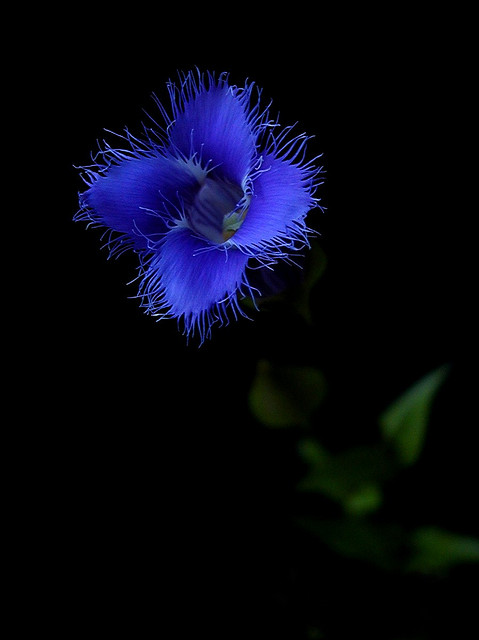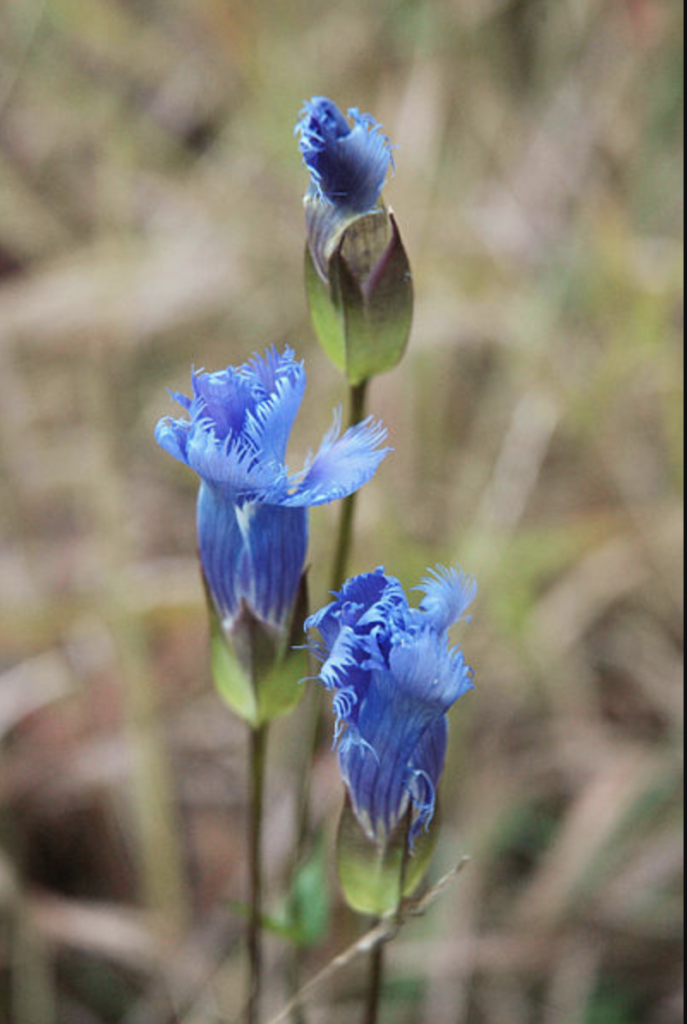To the Fringed Gentian*
By William Cullen Bryant
Annotations by Karen L. Kilcup

Thou blossom, bright with autumn dew, And coloured with the heaven’s own blue! That openest when the quiet light Succeeds the keen and frosty night. Thou comest not when violets lean O’er wandering brooks and springs unseen, Or columbines, in purple drest,[1] Nod o’er the ground-bird’s hidden nest.[2] Thou waitest late, and com’st alone, When woods are bare and birds are flown, And frosts and shortening days portend The aged year is near its end. Then doth thy sweet and quiet eye Look through its fringes to the sky, Blue—blue—as if that sky let fall A flower from its cerulean wall. I would that thus, when I shall see The hour of death draw near to me, Hope, blossoming within my heart, May look to heaven as I depart.
*[editor Lydia Maria Child’s note] The lines “To a Fringed Gentian” in the preceding number, were printed before Mr. Bryant honoured the Miscellany by one of his valuable communications. Had not the work been stitched for binding, before Mr. Bryant’s letter arrived, the editor would certainly have omitted any article to give place to it.
“To the Fringed Gentian,” juvenile miscellany 1, no. 2 (November 1828): 188.
[1] Violets and columbines are spring flowers in Bryant’s native New England.
[2] The ground-bird is the killdeer, a shorebird that nests inland. Its nests and speckled eggs are often invisible to observers until they come too near, when the bird will pretend to have a broken wing to lure the intruder away.

Wikimedia Commons CC-BY-SA-4.0
Contexts
Edited by writer and activist Lydia Maria Child, the Juvenile Miscellany was among the most notable antebellum children’s magazines. Child’s note suggests that author William Cullen Bryant was famous and that receiving his poem was an honor. As his Poetry Foundation biography asserts, “Bryant alerted the English-speaking world to an American voice in poetry.” Despite his immense fame and the popularity of his verses during much of the nineteenth century, few people know Bryant as a children’s poet. But his poem effectively addresses two audiences, including parents as well as children. Scholars cite this poem’s first appearance in Bryant’s Poems, published in 1832, but his younger readers came before this date. Teacher-editor Walter Barnes included “To the Fringed Gentian” in his 1919 text, Types of Children’s Literature: A Collection of the World’s Best Literature for Children, for Use in Colleges, Normal Schools, and Library Schools.
The autumn flower Gentianopsis crinita, or greater fringed-gentian, is native to all the New England states, though rare or threatened in some. It also appears in the upper Midwest and many of the Atlantic states, including Georgia. Its preferred habitat is open areas, such as fields and roadsides. For many Northerners, it has long been a beautiful and bittersweet indication of the coming winter.
Resources for Further Study
Gentianopsis crinita (Froel.) Ma: greater fringed-gentian. Native Land Trust, Go Botany. Framingham, MA.
Chafin, Linda G. Gentianopsis crinita (Froel) Ma: Fringed Gentian. Georgia Biodiversity Portal, Georgia Department of Natural Resources, Wildlife Resources Division.
Gentianopsis crinita (Froel.) Ma: Greater Fringed Gentian. Plant Database, Lady Bird Johnson Wildflower Center. The University of Texas at Austin.
Kilcup, Karen L. Who Killed American Poetry?: From National Obsession to Elite Possession. Athens: University of Georgia Press, 2019. A discussion of Bryant’s life and work appears in chapter 1.
Muller, Gilbert H. William Cullen Bryant: Author of America. Albany: State University of New York Press, 2008.
“William Cullen Bryant, 1784-1878.” Poetry Foundation. Has a substantial biography and large collection of Bryant’s poems. “William Cullen Bryant, 1784-1878.” Poets.org. Has a shorter biography and several of Bryant’s most famous poems.
Pedagogy
Breathitt County Schools has an instruction volume that includes Bryant and “To the Fringed Gentian,” with two study questions. See Part 1, Individualism and Nature, “American Romanticism: The Fireside Poets,” 200-201.
The poem’s old-fashioned language may make it difficult for today’s younger children, although many nineteenth-century children would not have found it especially challenging. Possible ways to engage students of all ages might be to use the poem as part of a nature- or natural history-oriented curriculum. If outdoor experiences are feasible, teachers could introduce students first to spring flowers in their local area (“columbines” and “violets”) and then, if the flower appears in the area, to the fringed gentian itself. Indoor experiences could focus on finding images of the flower and (depending on students’ learning levels), painting pictures of it, writing poems about it, or researching its botanical details and learning about its environmental status. Literary approaches for older students could emphasize the poem’s use of apostrophe, personification, and ballad structure.
Contemporary Connections
Bryant’s “To the Fringed Gentian” appears in numerous contemporary American literature anthologies. Like many of his other famous works, including “Thanatopsis” and “To a Waterfowl,” it may never have been out of print since the author first published it.
The William Cullen Bryant Homestead in Cummington, Massachusetts, is a National Historic Landmark and welcomes visitors. To learn more about this property, see “The Boyhood Home of One of America’s Foremost Poets.”
During the nineteenth century, many schools were named after the poet, and many still carry his name, including elementary schools in Cleveland, OH, Long Beach, CA, and Seattle, WA; and a high school in Queens, NY.